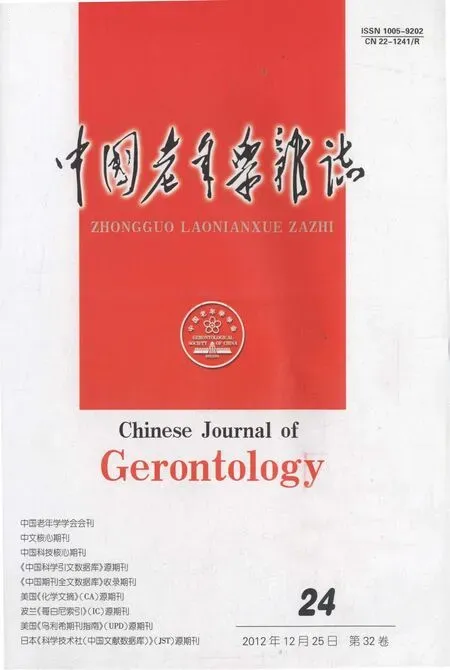海马神经发生与脑老化及针灸促神经发生效应
卢圣锋 尹海燕 于美玲 余曙光 唐 勇
(南京中医药大学针药结合省部共建教育部重点实验室,江苏 南京 210029)
神经发生有助于成年大脑正常功能的维持,也有利于神经退行性大脑疾病的自我修复,但随着年龄的增长,机体的这种能力会逐渐下降〔1〕。伴随脑老化的产生,神经发生水平显著降低,而海马神经发生与脑老化诱发的学习记忆减退密切相关,因此,深入了解海马神经发生的意义及其与脑老化的关系具有十分重要的意义。针灸作用整体性、综合性已基本达成共识,而且其主要是通过激活机体自身的内源性因素发挥效应。那么其对脑老化海马神经发生影响如何?为此,我们进行相应的总结。
1 海马神经发生的发现及意义
传统观点认为,中枢神经系统神经元缺乏再生能力,创伤和病理过程引发的神经元丢失无法逆转。但是,自1965年,Altman和Das报道在成年大鼠海马的齿状回(DG)颗粒下层(SGZ)发现神经干细胞(NSC)并有新生神经元产生以来〔2〕,脑内神经元缺乏再生能力的观点受到了极大的挑战。1997年,Gould和McEwen的团队证实,成年灵长类动物的海马也有NSC增殖的神经发生现象〔3〕,并在1998年进一步证实,真正的灵长类动物猿猴的海马中也存在神经发生〔4〕。同年,Eriksson等给予5位65~72岁患者BrdU注射标记NSC并在其去世后取材,首次证实人类海马也存在神经发生〔5〕。2007年,Manganas团队运用磁共振波谱成像技术(MRS)在活体人脑的研究成果证实人类海马存在神经发生〔6〕。至此,成年海马神经发生已在不同种属的研究中得到了广泛证实,这表明成年海马神经发生在种属间高度保守,是生物界的普遍现象〔7,8〕。海马神经发生的发现,为中枢神经系统疾病如老年痴呆、帕金森病、脑卒中、脑外伤等神经元变性、坏死的神经康复带来了新的希望〔9~12〕,而且围绕如何促进、调控海马神经发生,如何实现海马新生神经元的功能整合,成为重大前沿和研究热点〔13~18〕。
2 海马神经发生与脑老化
2.1 海马神经发生特征 神经发生贯穿生命体的一生,主要存在于两个脑区:侧脑室周围的室管膜下区(SVZ)和海马DG的SGZ〔19〕。成年神经发生首先是NSC和祖细胞的增殖。其中NSC是一类具有自我复制、自我更新能力、增殖和多种分化潜能的神经前体细胞;而祖细胞具有较高的增殖、有限的自我更新和多种分化潜能特征〔20〕。
NSC和祖细胞两者统称为神经前体细胞(NPCs),其通过增殖方式产生有能力分化为神经元或神经胶质细胞的未成熟细胞。在海马DG的神经发生,是以SGZ祖细胞增殖开始的,细胞分化后17 d,从海马门区或SGZ产生的新生神经元通过短暂迁移到达颗粒细胞层。4 w后,这些新生神经元具有成熟神经元的表征和形态,发出树突到分子层(ML)和发出轴突到CA3区,4~7 w后,具有形成功能链接必需的电生理特性,从而整合到神经回路,成为海马神经环路的一部分〔21〕。新生神经元长时程增强的阈值降低,是成熟颗粒细胞的1/10,从而对外来信息更敏感,加快信息编辑处理过程〔22,23〕。
2.2 海马神经发生与脑老化 脑老化中成年神经发生是减少的〔24~27〕。新生神经元的减少主要是由于 NPCs数量的减少、NPCs增殖减少或者新生神经元的存活和分化减少〔28,29〕。采用标记细胞有丝分裂的5-溴脱氧尿嘧啶核苷(BrdU)、增殖标记物Ki67或NH3进行评价,脑老化的啮齿类动物DG细胞增殖减少〔24,30,31〕。与啮齿类动物相反,灵长类动物 SGZ 成熟神经元减少主要是由于NPCs减少,而不是细胞增殖减少〔29〕。同时,在SVZ也发现存在差异,在衰老小鼠出现 NPCs增殖减少〔30,32〕,而在6 ~21 月龄的大鼠中,NPCs的增殖并没有发生改变,但新生神经元减少。这些表明,物种的不同可能导致神经发生障碍的机制不同,但都存在新生神经元减少现象。
在新生神经元的存活与分化研究中,通过采用(DCX)、多聚多液酸化神经细胞黏附分子(PSA-NCAM)或者微管蛋白β-Ⅲ(beta-Ⅲ-tubulin)标记短期存活,采用BrdU和成熟神经元标记物如NeuN和微管相关蛋白2(MAP2)共表达来标记长期存活,研究者观察到〔24〕,虽然老化小鼠 DG区 GCL和门区的NPCs增殖都减少,但这些细胞在接下来的4 w内,其存活率并没有减少;同样,在注射BrdU 5个月后,标记BrdU/NeuN的成熟神经元存活与对照组类似,提示整体细胞的减少主要原因是细胞增殖的减少。此外,有研究比较不同年龄小鼠神经发生状况,发现注射BrdU 4 w后,6月龄小鼠DG区BrdU/NeuN标记的成熟神经元多于18月龄动物。因此,在衰老伴随的脑老化过程中,成熟神经元数量是减少的〔32~35〕,这种减少主要与NSC增殖密切相关,而与存活和分化关系不大。
有学者认为脑老化并没有影响NSCs的数量,只是这些NSCs由于血管微生态的体积减少,而处于静息状态〔36〕。并且观察到衰老脑内诱发神经发生所需内环境发生变化,如成纤维细胞生长因子2(FGF-2),胰岛素生长因子1(IGF-1)和血管内皮生长因子(VEGF)在老年海马中都减少〔37〕。老化过程中,神经源性微环境发生改变,对NSC增殖或激活刺激不能产生相应响应,从而影响神经发生。当然,这也可能是由于微环境发生改变不能发出适当信号所导致。研究表明,增加亲神经因子或者减少抗神经因子,都可能改变NPCs增殖的数量,提示脑老化中出现的增殖受损是由于神经源性微环境改变所致〔38〕。如研究发现老化脑中与神经发生减少密切相关的抗神经因子主要是皮质类甾醇类〔39〕,当10周龄大鼠遭受慢性应激时,其SGZ区的NPCs增殖减少,恢复后3 w,其增殖水平增加,但仍低于正常水平,而应激与皮质类甾醇类密切相关。
海马神经发生水平与认知和学习记忆功能密切相关。海马成年神经发生在学习记忆中扮演着重要的角色,增加神经发生能够有效地改善认知功能〔40〕,除了动物研究得到证实外,在采用计算机神经科学理论进行的研究也证实了新神经元的产生能够提高学习记忆能力〔41〕,而且还发现新生神经元能够减轻记忆中干扰因素的作用〔42〕,同时增加记忆维持时间〔43〕。采用影响细胞增殖的毒素甲基氧化偶氮甲醇(MAM)或放射线方法来阻断神经发生,结果显示,MAM处理的大鼠DG区增殖减少,海马依赖性学习记忆能力下降;而用放射线处理的大鼠其Morris水迷宫测试不受影响,但其长时程空间记忆受到损害。
3 针灸促神经发生效应
针灸研究工作者开创了针灸神经康复机制研究领域的新方向,为相关疾病(如老年痴呆、脑梗死、癫痫等)的针灸作用原理阐释提供了更为丰富的实验依据。如,Kim等〔44〕以缺血蒙古沙鼠为研究对象,选择“足三里”穴位给予针刺治疗,采用BrdU神经发生标记技术检测发现,缺血鼠海马神经发生BrdU标记阳性细胞增多,“足三里”针刺组较之更有显著性增加,结果提示针刺能促进缺血后海马神经发生;Park等〔45〕则分别选择“足三里”和“神门”进行比较研究。结果发现,出生14 d后与母鼠分离的幼鼠接受“神门”针刺,海马神经发生的促进效应更为显著;同时,Kim研究组以耳针的研究结果也证实,耳针可以显著促进缺血鼠海马神经发生〔46〕;另外,Kim研究组还在糖尿病大鼠的研究中证实,针刺、艾灸均可以明显促进海马神经发生〔47〕。研究者们以脑梗死或缺血缺氧性脑病模型或老年痴呆为研究对象的结果也表明,针灸治疗不仅可以提高学习记忆能力,还可以促进海马神经发生,增加海马神经干细胞巢蛋白(nestin)表达,促进海马NSC增殖、迁移和分化〔48~50〕。另有研究者电针刺激癫痫模型大鼠“百会”穴,通过行为学、BrdU海马神经发生标记研究发现,电针穴位刺激后,明显促进了大鼠致痫后7、14 d时海马的神经发生水平,BrdU免疫阳性细胞数目、生长抑素(SS)表达均较相应对照组明显增加〔51,52〕。
4 小结
总之,在DG区产生新的神经元越多,整合到神经环路的神经元愈多,从而越有利于学习。当然,也有可能在新神经元未完全成熟之前就参与影响学习的过程〔53〕。啮齿类动物海马神经发生减少与脑老化学习记忆能力降低相关密切是个不争的事实,其最突出的表现是NPCs增殖减少〔24,25〕。而对于灵长类,则可能存在不同的机制。神经发生主要包括神经干细胞的增殖、分化、迁移、存活及整合到神经回路过程,对于这些过程的理解,目前还没有达到一致的认识。海马是学习记忆的重要脑区,是脑老化受损部位,海马神经元丢失、变性、坏死,突触减少,以及与学习记忆相关的神经递质减少直接影响学习记忆能力〔54〕。海马神经发生可替代受损神经元,形成新的突触,发挥突触可塑性,实现神经回路的功能整合,最终提高学习记忆能力。中枢神经系统也是针灸作用的重要调控部位,在针灸镇痛、针刺麻醉、针刺戒毒、针灸镇静、醒脑开窍、活血化瘀、抗抑郁、抗焦虑、延缓衰老、针灸减肥、神经免疫网络调节、针灸脑功能调整、针灸对脏腑功能调整等众多的针灸作用原理研究领域中占有重要的地位。已有的研究不仅表明,针灸可以调整病理状态下紊乱的脑功能,促使恢复到正常的生理状态,而且,还可以通过诱导或调动机体内源性因素以促进机体康复。
1 Galvan V,Jin K.Neurogenesis in the aging brain〔J〕.Clin Interv Aging,2007;2(4):605-10.
2 Altman J,Das GD.Autoradiographic and histological evidence of postnatal hippocampal neurogenesis in rats〔J〕.J Comp Neurol,1965;124(3):319-35.
3 Gould E,McEwen BS,Tanapat P,et al.Neurogenesis in the dentate gyrus of the adult tree shrew is regulated by psychosocial stress and NMDA receptor activation〔J〕.J Neurosci,1997;17(7):2492-8.
4 Gould E,Vail N,Wagers M,et al.Adult-generated hippocampal and neocortical neurons in macaques have a transient existence〔J〕.PNAS,2001;98(19):10910-7.
5 Eriksson PS,Perfilieva E,Bjork-Eriksson T,et al.Neurogenesis in the adult human hippocampus〔J〕.Nat Med,1998;4(11):1313-7.
6 Manganas LN,Zhang X,Li Y,et al.Magnetic resonance spectroscopy identifies neural progenitor cells in the live human brain〔J〕.Science,2007;318(5852):980-5.
7 Knoth R,Singec I,Ditter M,et al.Murine features of neurogenesis in the human Hippocampus across the lifespan from 0 to 100 years〔J〕.PLoS One,2010;29:5(1):e8809.
8 Curtis MA,Kam M,Faull RL.Neurogenesis in humans〔J〕.Eur J Neurosci,2011;33(6):1170-4.
9 Lie DC,Song H,Colamarino SA,et al.Neurogenesis in the adult brain:New strategies for central nervous system diseases〔J〕.Annu Rev Pharmacol Toxicol,2004;44:399-421.
10 Decarolis NA,Eisch AJ.Hippocampal neurogenesis as a target for the treatment of mental illness:A critical evaluation〔J〕.Neuropharmacology,2010;58(6):884-93.
11 Winner B,Kohl Z,Gage FH.Neurodegenerative disease and adult neurogenesis〔J〕.Eur J Neurosci,2011;33(6):1139-51.
12 Taupin P.Neurogenesis,NSCs,pathogenesis and therapies for Alzheimer's disease〔J〕.Front Biosci(Schol Ed),2011;3:178-90.
13 Laplagne DA,Espósito MS,Piatti VC,et al.Functional convergence of neurons generated in the developing and adult hippocampus〔J〕.PLoS Biol,2006;4(12):e409.
14 Ge S,Goh EL,Sailor KA,et al.GABA regulates synaptic integration of newly generated neurons in the adult brain〔J〕.Nature,2006;439(7076):589-93.
15 Duan X,Chang JH,Ge S,et al.Disrupted-In-Schizophrenia 1 regulates integration of newly generated neurons in the adult brain〔J〕.Cell,2007;130(6):1146-58.
16 Ehninger D,Kempermann G.Neurogenesis in the adult hippocampus〔J〕.Cell Tissue Res,2008;331(1):243-50.
17 Ma DK,Jang MH,Guo JU,et al.Neuronal activity-induced Gadd45b promotes epigenetic DNA demethylation and adult neurogenesis〔J〕.Science,2009;323(5917):1074-7.
18 Knobloch M,Jessberger S.Perspectives on adult neurogenesis〔J〕.Eur J Neurosci,2011;33(6):1013-7.
19 Zhao C,Deng W,Gage FH.Mechanisms and functional implications of adult neurogenesis〔J〕.Cell,2008;132(4):645-60.
20 Shruster A,Melamed E,Offen D.Neurogenesis in the aged and neurodegenerative brain〔J〕.Apoptosis,2010;15(11):1415-21.
21 Burger C.Region-specific genetic alterations in the aging hippocampus:implications for cognitive aging〔J〕.Front Aging Neurosci,2010;2:140.
22 Couillard-Despres S,Winner B,Karl C,et al.Targeted transgene expression in neuronal precursors:watching young neurons in the old brain〔J〕.Eur J Neurosci,2006;24(6):1535-45.
23 Schmidt-Hieber C,Jonas P,Bischofberger J.Enhanced synaptic plasticity in newly generated granule cells of the adult hippocampus〔J〕.Nature,2004;429(6988):184-7.
24 Rao MS,Hattiangady B,Abdel-Rahman A,et al.Newly born cells in the ageing dentate gyrus display normal migration,survival and neuronal fate choice but endure retarded early maturation〔J〕.Eur J Neurosci,2005;21(2):464-76.
25 Dupret D,Revest JM,Koehl M,et al.Spatial relational memory requires hippocampal adult neurogenesis〔J〕.PLoS One,2008;3(4):e1959.
26 Morgenstern NA,Lombardi G,Schinder AF.Newborn granule cells in the ageing dentate gyrus〔J〕.J.Physiol,2008;586(16):3751-7.
27 Toni N,Laplagne DA,Zhao C,et al.Neurons born in the adult dentate gyrus form functional synapses with target cells〔J〕.Nat Neurosci,2008;11(8):901-7.
28 Hattiangady B,Shetty AK.Aging does not alter the number or phenotype of putative stem/progenitor cells in the neurogenic region of the hippocampus〔J〕.Neurobiol Aging,2008;29(1):129-47.
29 Aizawa K,Ageyama N,Terao K,et al.Primate specific alterations in neural stem/progenitor cells in the aged hippocampus〔J〕.Neurobiol Aging,2011;32(1):140-50.
30 Enwere E,Shingo T,Gregg C,et al.Aging results in reduced epidermal growth factor receptor signaling,diminished olfactory neurogenesis,and deficits in fine olfactory discrimination〔J〕.J Neurosci,2004;24(38):8354-65.
31 Cuppini R,Bucherelli C,Ambrogini P,et al.Age-related naturally occurring depression of hippocampal neurogenesis does not affect trace fear conditioning〔J〕.Hippocampus,2006;16(2):141-8.
32 Molofsky AV,Slutsky SG,Joseph NM,et al.Increasing p16INK4a expression decreases forebrain progenitors and neurogenesis during ageing〔J〕.Nature,2006;443(7110):448-52.
33 Van Praag H,Shubert T,Zhao C,et al.Exercise enhances learning and hippocampal neurogenesis in aged mice〔J〕.J Neurosci,2005;25(38):8680-5.
34Heine VM,Maslam S,Jo¨els M,et al.Prominent decline of newborn cell proliferation,differentiation,and apoptosis in the aging dentate gyrus,in absence of an age-related hypothalamus-pituitary-adrenal axis activation〔J〕.Neurobiol Aging,2004;25(3):361-75.
35 Driscoll I,Howard S,Stone J,et al.The aging hippocampus:a multi-level analysis in the rat〔J〕.Neuroscience,2006;139(4):1173-85.
36 Lugert S,Basak O,Knuckles P,et al.Quiescent and active hippocampal neural stem cells with distinct morphologies respond selectively to physiological and pathological stimuli and aging〔J〕.Cell Stem Cell,2010;6(5):445-56.
37 Shetty AK,Hattiangady B,Shetty GA.Stem/progenitor cell proliferation factors FGF-2,IGF-1,and VEGF exhibit early decline during the course of aging in the hippocampus:role of astrocytes〔J〕.Glia,2005;51(3):173-86.
38 Jin K,Sun Y,Xie L,et al.Neurogenesis and aging:FGF-2 and HB-EGF restore neurogenesis in hippocampus and subventricular zone of aged mice〔J〕.Aging Cell,2003;2(3):175-83.
39 Heine V,Maslam S,Zareno J,et al.Suppressed proliferation and apoptotic changes in the rat dentate gyrus after acute and chronic stress are reversible〔J〕.Eur J Neurosci,2004;19(1):131-44.
40 Neves FG,Cooke SF,Bliss TV.Synaptic plasticity,memory and the hippocampus:A neural network approach to causality〔J〕.Nature Rev Neurosci,2008;9(1):65-75.
41 Becker S.A computational principle for hippocampal learning and neurogenesis〔J〕.Hippocampus,2005;15(6):722-38.
42 Wiskott L,Rasch MJ,Kempermann G.A functional hypothesis for adult hippocampal neurogenesis:avoidance of catastrophic interference in the dentate gyrus〔J〕.Hippocampus,2006;16(3):329-43.
43 Aimone JB,Wiles J,Gage FH.Potential role for adult neurogenesis in the encoding of time in new memories〔J〕.Nat Neurosci,2006;9(6):723-7.
44 Kim EH,Kim YJ,Lee HJ,et al.Acupuncture increases cell proliferation in dentate gyrus after transient global ischemia in gerbils〔J〕.Neurosci Lett,2001;297(1):21-4.
45 Park HJ,Lim S,Lee HS,et al.Acupuncture enhances cell proliferation in dentate gyrus of maternally-separated rats〔J〕.Neurosci Lett,2002;319(3):153-6.
46 Kim EH,Chung JH,Kim CJ.Auricular acupuncture increases cell proliferation in the dentate gyrus of Sprague-Dawley rats〔J〕.Acupunct Electrother Res,2001;26(3):187-94.
47 Kim EH,Jang MH,Shin MC,et al.Acupuncture increases cell proliferation and neuropeptide Y expression in dentate gyrus of streptozotocin-induced diabetic rats〔J〕.Neurosci Lett,2002;327(1):33-6.
48 唐 勇,卢圣锋,乔秀兰,等.艾灸对SAMP8小鼠海马神经干细胞分化的影响〔J〕.中国康复医学杂志,2010;25(4):301-4.
49 乔秀兰,卢圣锋,尹海燕,等.针灸对SAMP8小鼠皮层神经干细胞增殖分化的影响〔J〕.中国老年学杂志,2010;30(1):38-41.
50 Cheng HY,Yu JC,Jiang ZG,et al.Acupuncture improves cognitive deficits and regulates the brain cell proliferation of SAMP8 mice〔J〕.Neurosci Lett,2008;432(1):111-6.
51 王津存,黄远桂,温晓妮,等.电针穴位刺激对致痫大鼠海马齿状回神经发生及行为学变化影响的实验研究〔J〕.第四军医大学学报,2006;27(5):441-4.
52 温晓妮,黄远桂.电针对慢性癫痫大鼠海马新生神经元生长抑素表达的影响〔J〕.西安交通大学学报(医学版),2008;29(4):370-3.
53 Leuner B,Gould E,Shors TJ.Is there a link between adult neurogenesis and learning〔J〕?Hippocampus,2006;16(3):216-24.
54 Deng W,Aimone JB,Gage FH.New neurons and new memories:how does adult hippocampal neurogenesis affect learning and memory〔J〕?Nat Rev Neurosci,2010;11(5):339-50.

